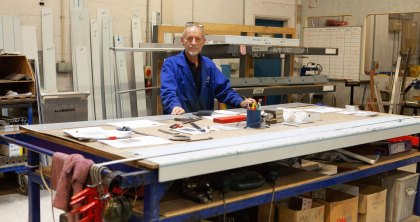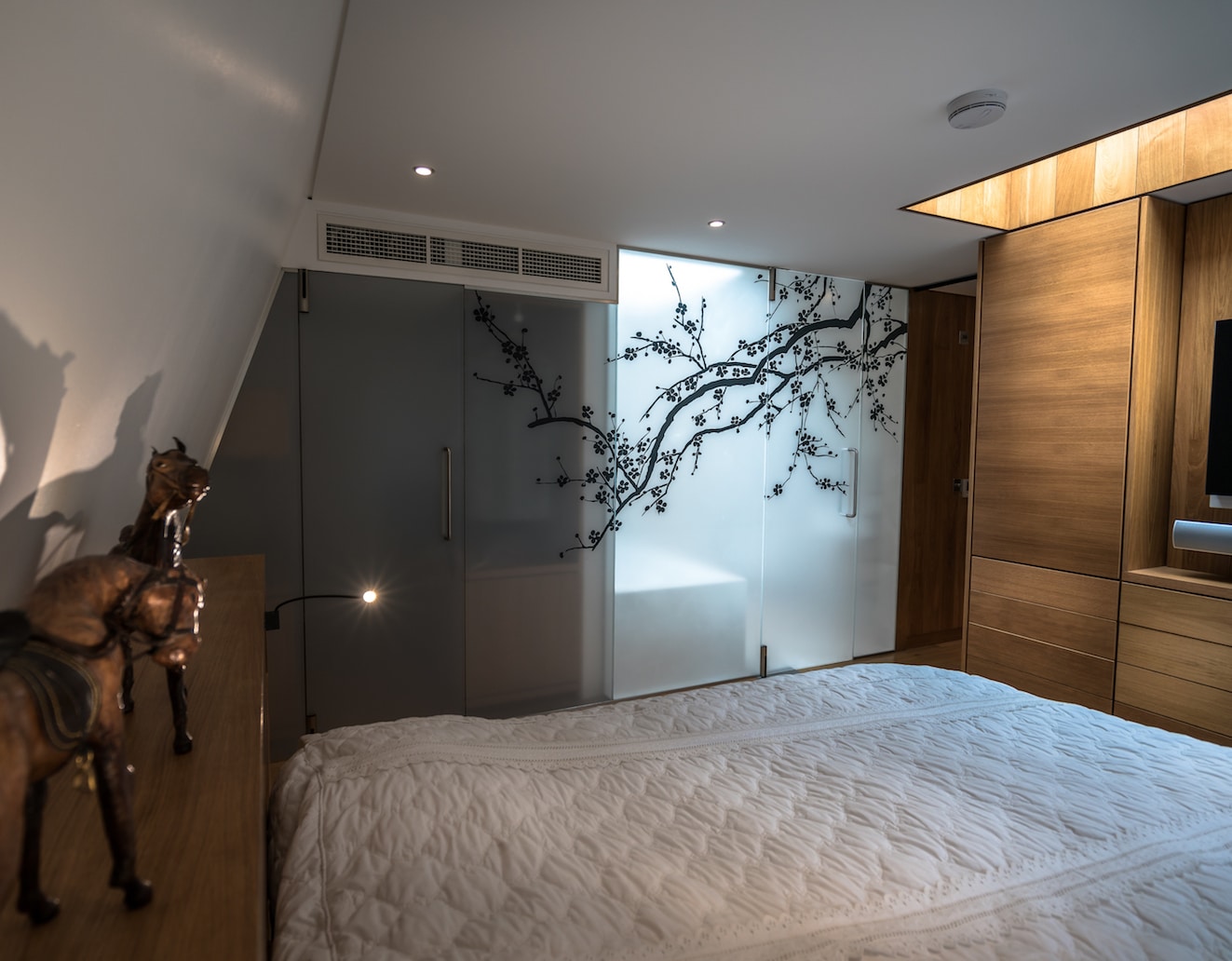Project Details:
Architect:
Robinson Leigh Architects
Products used:
Architects overcome opposition to add mansard roof extension to London mews house
After a particularly contentious and protracted planning process, this semi-detached, red-bricked house, part of a group of five properties that form Regent’s Mews in affluent London NW8, finally boasts an impressive third storey extension as a result of the erection of a mansard roof. The new dormer windows to its front aspect lend this 1980’s property a delightfully modern aesthetic, whilst the provision of a green roof to the rear aspect underlines its eco-credentials. The installation of Glazing Vision’s elegant sliding rooflight above the stairwell, together with 4 additional fixed rooflights, has maximised the light streaming into this new living space, and also provided an all-important source of ventilation.
Appearance and privacy concerns in a conservation area
Initial proposals to convert this house from two to three floors were rejected way back in 2001 by the local Planning Department on the grounds of it being “visually intrusive, overbearing massing not part of the existing architectural language and overlooking neighbours”. These same considerations faced Robinson Leigh Architects, whose track record of successful planning application had led to their appointment in 2013 by a client keen to find a solution to the planning impasse.
There were a number of challenges for the architects, as they sought to design a scheme that would prove more successful through planning. The house is situated in St John’s Wood Conservation area, where restrictions on the character and appearance of all buildings are strictly applied. Normally any roof extension in this area would not be permitted and the house, indeed the entire mews, had been identified as an “unlisted building of merit”. Consequently the planners insisted that all new work to the house “must match existing original work in terms of choice of materials, method of construction and finished appearance in order to maintain the cohesion of the mews.
The variety of roof forms in the mews, however, presented an opportunity for the architects to put forward their proposal of a flat-topped mansard roof as “a modern interpretation of the surrounding architectural precedent” said Leigh. Critically, the new mansard roof would also not add height above the general roof level of the neighbouring properties in Regent’s Mews, and thus would not be visually intrusive. The design of the three new dormer windows at the front of the house did depart from that of the dormer windows on the other mews houses though – they were square in contrast to the prevalent curved headed windows. However, given that they were really only visible from within the actual mews, the planners considered this alteration in form to be acceptable. Furthermore, the recessed glazing of the dormer windows ensured that the privacy of the occupants using the living spaces would not be compromised.
The choice of materials also had to conform to the surrounding properties: the dormer windows were lead-clad, and the roof was tiled in Welsh slate, which softens its appearance and reduces the “apparent bulk of the structure.
Glazing arrangement within the mansard roof
Another complication for Robinson Leigh related to the impact upon the large villas of Langford Place to the rear of the property. Vehement objections from these residents, who were concerned that the roof extension would shatter the illusion that they are set in extensive grounds led the architects to revise their proposal: the pitch of the northwest slope of the mansard roof was adjusted to a 70 degree angle in order to reduce its prominence in the views from these villas, particularly from 5 Langford Place. A second flat roof, which adjoined the house was removed, and Robinson Leigh extended the mansard roof to the parapet. This then gave the client more internal space, eliminated any overlooking issues, and created a more homogenous and symmetrical design.
The architects cleverly designed both the main roof level of the mansard to be landscaped with indigenous flora in order to respect the planners’ preference for ecological biodiversity in the area as well as to attenuate water run-off.
Unlocking natural daylight on the new top floor
In conjunction with these structural requirements imposed on Robinson Leigh’s design of the mansard roof, unlocking natural daylight in the “dark zones” in the interior of the new storey was a key priority. Mindful of the rejection of the glazed roof proposal from 2001, which the planners had deemed to be too intrusive on the neighbours and at odds with the surrounding architecture, the architects sought to reduce the amount glazed by 50%, whilst simultaneously addressing the problem of reduced levels of natural daylight resulting from the recessed dormer windows.
Robinson Leigh’s solution was to propose a more sympathetic glazing arrangement to the flat-top of the mansard roof, comprising four large Fluzeglaze fixed rooflights and a sliding over fixed rooflight from Glazing Vision, that would achieve the high specification they desired. These rooflights, pointed upwards to the sky, would maximise the amount of daylight entering the extension and bouncing off the hardwood timber, which had been used extensively, as Leigh points out, to “draw together several disparate elements of the interior design, such as the sliding walls, pocket doors and floor-to-ceiling shelving and cupboards”.
Bespoke opening rooflight above the stairwell
Glazing Vision’s sliding over fixed rooflight was to inhabit the space immediately above the stairwell, which had also been lined in timber to subtly link the top floor with the ground floor and to help draw the eye upwards. Timber frames had also been used on the windows. As with the other four rooflights, Glazing Vision’s sliding over fixed rooflight needed to be made to a bespoke size – the architects required it to be the exact size of the stairwell, or indeed over-sized, so that the frames were not visible from below. Precision-engineered at the Glazing Vision factory in Norfolk, the special sliding over fixed rooflight was supplied in two sections, with an overall span of 2400mm and a width of 2240mm. The minimalist internal framework, finished in pure white rather than the standard grey, ensured that there were unfettered, sky-only views from the inside, thereby enhancing the impression of space and loft. Through the clear glazing of the Glazing Vision rooflight natural daylight absolutely flooded the stairwell, permeating also down to the lower floors.
Given the stringent planning controls on the appearance of the mansard roof and the concerns of the vociferous neighbours, Glazing Vision’s sliding over fixed rooflight offered another invaluable benefit to Robinson Leigh. The footprint of the unit on the roof remained fixed, both open and close. This meant that there was no bulky additional furniture required, whilst the minimalist exterior framework was finished in slate grey to blend harmoniously with the Welsh slate roof tiles.
Letting in the air
No less important was the need for natural ventilation in the mansard roof extension. The architects were keen to create a venturi effect in the central core of the house and stairwell by channeling the airflow through the opening of the rooflight. The Glazing Vision rooflight, specified by Robinson Leigh to slide side-to-side rather than up and down, is electronically controlled at the touch of a button from inside the house, retracting the sliding section over the fixed section of glazing. Once the sliding section is fully retracted, there is a 50% clear opening in the rooflight, out towards the sky, thus providing superior air quality within the top floor, as well as intensifying the amount of natural daylight. An essential security feature of the Glazing Vision sliding-over fixed rooflight is that it is supplied with a manual override as standard.
The design, approval and erection of the mansard roof extension took three years but Robinson Leigh have succeeded in updating a tired-looking 1980’s mews house with a new, sophisticated, modern exterior, that quietly complements the surrounding properties. The new third storey has exceeded the client’s needs for additional living space, and the clever use of rooflights has ensured the interior is light, bright and inviting.
You can view the light-enhancing property in the 360 video below:
Video credit: nicolas@dasslerphotography.com
For more information on Glazing Vision’s sliding-over fixed rooflights or advice for your next project, contact us or request a CPD.
Make an Enquiry
Make an Enquiry
Fields marked * are required























